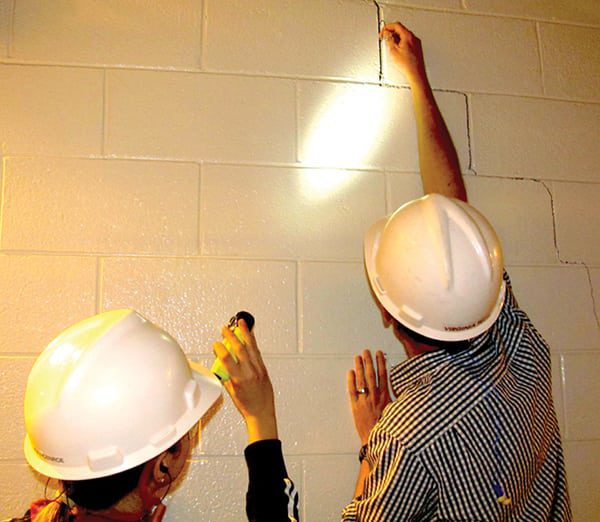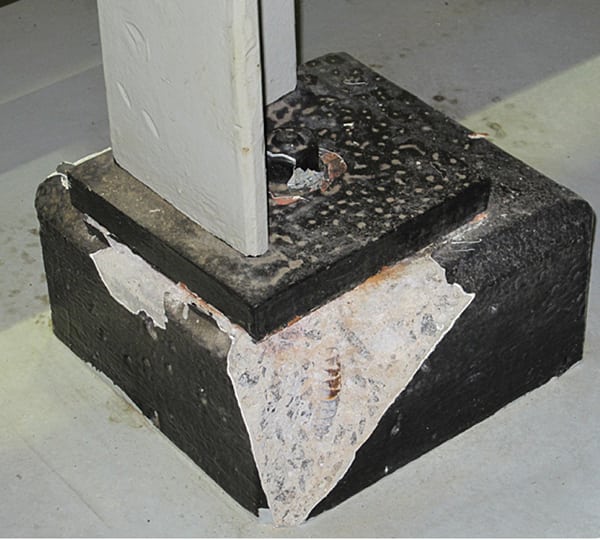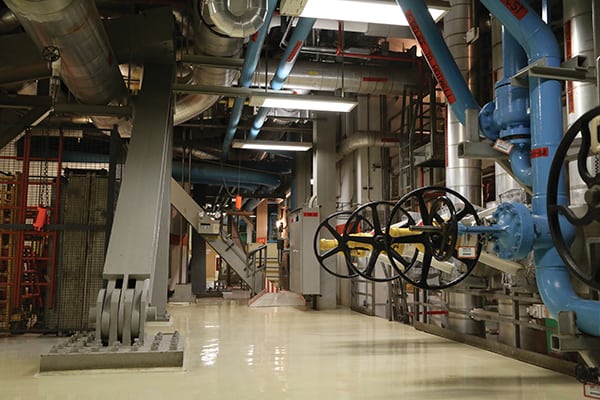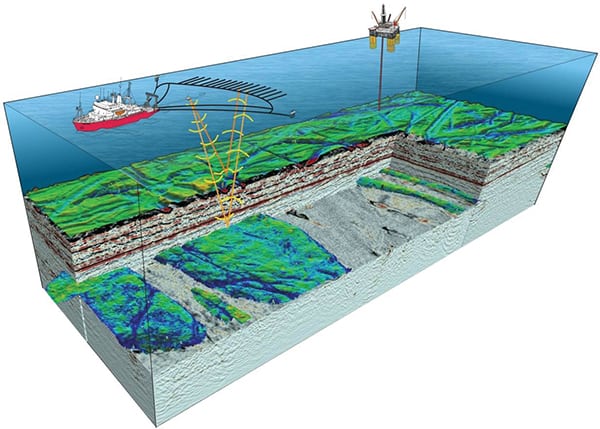Seismic Hazard Resiliency at U.S. Nuclear Power Plants
Since the beginning of the U.S. commercial reactor industry, regulatory agencies have required that nuclear power plant designs take into account the potential threats posed by natural hazards such as earthquakes and floods. The tsunami-caused disaster in Japan in 2011 prompted renewed attention worldwide on these hazards.
Given the devastation caused at Japan’s Fukushima Daiichi Nuclear Power Station by the tsunami that was triggered by the Mar. 11, 2011, magnitude 9.0 Great East Japan Earthquake, it’s no wonder that many people both inside and outside of the power industry have raised questions about the vulnerability of the U.S. nuclear fleet to similar natural disasters. The questions about plants sited on oceans have been particularly acute.
No power plant can guarantee that it will never incur any damage from major natural disasters. However, there is a long history of regulatory review and requirements in the U.S. nuclear sector concerned with such risks. As new knowledge about geology, seismic and tsunami risks, and operational and design best practices emerges, regulatory oversight also has changed.
The Nuclear Regulatory Commission (NRC), its predecessor agencies, and nuclear industry groups have all pursued initiatives to consider risks from natural phenomena, such as earthquakes and floods. Even though the NRC is recognized as the preeminent nuclear regulatory body internationally, concerns about the safety of nuclear plants were understandably heightened by the Japanese disaster. This article looks at the current level of seismic risk assessment as it concerns both earthquakes and seismically triggered tsunamis and recent responses to the latest understanding of that risk. Details of specific plant changes to equipment and procedures are beyond the scope of this article.
Tsunami Risk
It is important to remember that the massive destruction at the Fukushima Daiichi units was directly and indirectly caused by the tsunami, not the triggering earthquake. For U.S. coastal nuclear plants, that’s mostly good news.
According to the World Nuclear Association (WNA), the original design basis tsunami height for the Fukushima Daiichi plant was 3.1 meters. That was based on assessment of the 1960 Chile tsunami. The plant was actually built about 10 meters above sea level with the seawater pumps 4 meters above sea level. In 2002 “the design basis was revised to 5.7 metres above, and the seawater pumps were sealed. Tsunami heights coming ashore were about 15 metres, and the Daiichi turbine halls were under some 5 metres of seawater until levels subsided…. The maximum amplitude of this tsunami was 23 metres at point of origin, about 180 km from Fukushima.”
The WNA adds: “In the last century there have been eight tsunamis in the region with maximum amplitudes at origin above 10 metres (some much more), these having arisen from earthquakes of magnitude 7.7 to 8.4, on average one every 12 years.”
In the continental U.S., tsunamis are not unheard of; however, the threat posed by tsunamis hitting U.S. coasts cannot easily be extrapolated from tsunamis elsewhere, as seismic behavior is very region- and site-specific.
As one example, Pacific Gas & Electric (PG&E), owner and operator of the Diablo Canyon Power Plant (DCPP), has evaluated the possible effect of three tsunami sources: those from large distant earthquakes, from local offshore earthquakes, and from landslides. The company says that, “For the distant tsunami, a wave height of 6.1 m was used based on the largest observed wave heights along the California coast (Crescent City) from distant earthquakes. This wave height is larger than anything observed in the vicinity of Diablo Canyon, and it is combined with storm waves and tides to give a total wave height of 8.4 m above mean sea level. For the local tsunamis, a tsunami wave height of 2.6 m was estimated based on modeling of tsunamis generated from local offshore earthquakes. It is combined with storm waves and tides to give a total wave height of 9.8 m above mean sea level. The 9.8 m height is the design basis.”
PG&E has also looked at the possibility of a wave larger than design basis and found that “beyond design basis wave heights could be generated from large offshore landslides, but they are very rare (2 in a million chances per year). Tsunami [waves] reaching the height of the power block (25.9 m) have about a 1 in 7 million chance per year.”
In 2010, as part of its Long Term Seismic Program update, PG&E conducted an exploratory trial application on its own of a draft Probabilistic Tsunami Hazard Analysis (PTHA) for the DCPP site. As PG&E told POWER in early March, this was a pilot study only for how to potentially conduct a PTHA and did not represent a definitive analysis. The NRC later issued guidance to the industry on how to reevaluate flooding hazards, and the utility is submitting that report on Mar. 12 (as this issue goes to press). In brief, that report, which looked at tsunami sources, including underwater earthquakes and landslides, shows the new tsunami height that could potentially impact the plant is approximately 30 feet.
Although most people think of California as the most seismically active, the East Coast also has had earthquake and tsunami activity.
In a 2013 presentation to the Seismological Society of America, John Ebel, a Boston College seismologist, suggested that New England could be most vulnerable to future tsunamis. Several earthquakes on the edge of the Atlantic continental shelf in 2012 (magnitudes between 2 and 3.5) have prompted more attention to the potential for East Coast tsunamis. Though these recent quakes were relatively small, a 1929 magnitude 7.2 earthquake, also at the edge of the continental shelf, triggered a tsunami that hit southern Newfoundland, Canada, with water as high as 13 m. That tsunami killed 28, displaced tens of thousands, and caused massive damage. Natural Resources Canada says the tsunami was recorded along the eastern seaboard as far south as South Carolina and across the Atlantic Ocean in Portugal. Though Ebel notes that more research is necessary to better characterize any future risk, the basic conditions, and precedent, are there.
The U.S. Geological Survey (USGS) says the Pacific Coast states are most vulnerable to tsunami and lists seven recorded earthquake-generated tsunami events that have affected the U.S. According to the USGS, tsunamis can be “triggered by earthquakes, volcanic eruptions, submarine landslides, and by onshore landslides in which large volumes of debris fall into the water. All of these triggers can occur in the United States.”
A 2005 report, “The Tsunami Threat to California,” prepared by the state after the devastating Sumatra tsunami of Dec. 26, 2004, says that “Over 80 tsunamis have been observed or recorded along the coast of California in the past 150 years, 9 causing minor damage in ports and harbors and 2 with major impacts. Four events caused deaths; the worst occurred in 1964 when 12 people died in California from the tsunami generated by the Great Alaska earthquake.” Though the report did not mention nuclear plants specifically, it did note that withdrawing waves can damage power plants that use seawater for cooling.
Although the original licenses for U.S. coastal nuclear plants were issued before we knew much about tsunami hazards, regulators did consider flooding from hurricane storm surges, which the NRC says are expected to be greater than flooding from potential tsunamis.
Earthquakes Affecting U.S. Nuclear Plants
The only time an earthquake has forced a U.S. nuclear plant offline was in August 2011 (five months after the Fukushima accident), when a magnitude 5.8 quake with an epicenter 11 miles from Dominion’s 1,865-MW North Anna Power Station in Mineral, Va., knocked both units offline. North Anna was also the first U.S. plant to experience an event that exceeded its design basis.
Both units shut down immediately, automatically, and safely. Though the plant lost off-site power from the switchyard, back-up power from diesel generators picked up the load within 8 seconds, as designed, and the station returned to off-site power later that evening. Details of the station’s immediate actions and recovery plan were published in POWER’ s November 2012 issue: “Dominion’s North Anna Station Sets New Standard for Earthquake Response.” Because such events are rare and Dominion successfully handled the response to this quake, we recommend reading this account.
As that earlier article noted, the plant fared quite well: “While the ground force accelerations from the earthquake did exceed North Anna’s licensed design basis for about 3 seconds, the station—built with multiple layers of safety—sustained no functional damage to safety systems, structures, or components. In fact, the extensive engineering analysis completed by the company demonstrated that it could have safely withstood a quake well above that experienced” (Figure 1).
Future Seismic Risks
As seismic hazard assessment improves, in part from knowledge gained from new earthquakes as well as new monitoring, modeling, and analysis techniques, some plants that were designed for one level of seismic risk will be found to be sited in an area with a different level of risk. That’s the case with the most currently contentious plant, Diablo Canyon Power Plant.
DCPP, near San Luis Obispo, Calif., has two 1,100-MW Westinghouse pressurized water reactors and was designed to withstand the strongest potential earthquakes from four known faults (magnitude 6.75), as understood at the time construction began in 1965. During construction, the plant was upgraded to withstand a 7.5 magnitude earthquake after the Hosgri Fault was discovered by geologists surveying the continental shelf for oil and it was postulated that this fault might produce a magnitude 7.5 earthquake. Safety-related modifications were made (Figure 2), and the units went online in 1985 and 1986.
More recently, the Shoreline Fault was found in 2008, less than half a mile from the plant. That has led to public concern that the plant may not be able to withstand a quake originating along that fault. Knowledge about this newly discovered fault has led to, among other actions, environmental group Friends of the Earth filing a petition with the NRC in August last year to shut down the plant, whose operating licenses expire in 2024 and 2025. Friends of the Earth claims the NRC illegally allowed the utility to operate the plant outside of the conditions of its license as regards seismic hazards. In February the U.S. Court of Appeals for the District of Columbia agreed to hear the case. (For more details on the controversy see POWER’ s Dec, 4, 2014, coverage in “Diablo Canyon Nuclear Plant: Solid as a Rock or Ready to Crumble?”)
PG&E spokesperson Blair Jones told POWER, “Diablo Canyon was built with earthquake safety at the forefront, is a seismically safe facility, and is in compliance with NRC licensing requirements. Friends of the Earth is mischaracterizing the facts regarding the seismic design of the facility, and we look forward to providing the court with factual information, including why the Friends of the Earth’s petition is meritless.”
PG&E’s website says the Long Term Seismic Program “continually assesses seismic safety at the facility. The LTSP is a unique program in the U.S. commercial nuclear power plant industry. It is comprised of a geosciences team of professionals who partner with independent seismic experts on an ongoing basis to evaluate regional geology and global seismic events to ensure the facility remains safe.”
That work included low- and high-energy seismic research in 2012 that used equipment onboard a research vessel that “generated low-energy sound waves that were directed toward the ocean bottom. An array of sensors, or hydrophones, towed behind the vessel captured the sound waves as they reflected back to the surface. The data were recorded and used to create a detailed three-dimensional map of offshore seismic faults,” according to PG&E’s website.
Seismometers were also deployed on the sea floor as passive listening devices that are used to detect and record seismic activity near the plant, which is then analyzed by experts.
In September 2014, PG&E sent to the NRC and the California Public Utilities Commission a report based on this research. In the news release about the report, Senior Vice President and Chief Nuclear Officer Ed Halpin was quoted as saying, “This research effort, utilizing the latest technologies, demonstrates Diablo Canyon continues to be seismically safe…. These studies provide scientists and regulators an unprecedented scientific analysis of the seismic characteristics near Diablo Canyon.”
As a result of both extensive oil and gas exploration and PG&E’s unique seismic research program (Figure 3), there is general agreement that the seismic region around Diablo Canyon is among the most studied and understood in the nation. PG&E’s Jones told POWER that the new seismic reevaluation, filed with the NRC on Mar. 12, “reconfirms the plant’s earthquake design basis.” In the event of a beyond-design-basis earthquake, the company will use FLEX equipment to provide cooling.
Regulating Safety in Response to Seismic Risk
Nobody can guarantee that Diablo Canyon or any other nuclear power plant will never experience a beyond-design-basis earthquake or tsunami, but what regulators can do is ensure that operators adhere to all the applicable orders and regulations.
U.S. nuclear plants were originally designed using a “deterministic” approach accounting for maximum earthquake potential and local geology. The NRC defines safe shutdown earthquake (SSE) as “the maximum earthquake potential for which certain structures, systems, and components, important to safety, are designed to sustain and remain functional.” In 1997, the NRC published new geologic and seismic criteria through which the SSE and uncertainties are addressed through a probabilistic seismic hazard analysis.
The NRC explains probabilistic risk assessment as “A systematic method for assessing three questions that the NRC uses to define ‘risk.’ These questions consider (1) what can go wrong, (2) how likely it is, and (3) what its consequences might be. These questions allow the NRC to understand likely outcomes, sensitivities, areas of importance, system interactions, and areas of uncertainty, which the staff can use to identify risk-significant scenarios.”
The NRC website has voluminous information about seismic risks, the regulatory and guidance history as it relates to these risks, as well as the most recent technical documents created in response to the Japanese disaster. This article must necessarily provide only an overview; those interested in the details should consult the NRC website.
Assessing Seismic Risk. Since the first U.S. commercial reactors were built, the NRC and its predecessors have required that nuclear power plant design take into account known hazards. Regarding seismic risks, even plants that are not located in areas of “extensive seismic activity” are designed for safety in the event of such activity.
For operating plants, the NRC used a deterministic process that requires that safety-significant structures, systems, and components be designed to take into account:
■ The most severe natural phenomena historically reported for the site and surrounding area. The NRC then adds a margin for error to account for the limited historical data accuracy.
■ Appropriate combinations of the effects of normal and accident conditions with the effects of the natural phenomena.
■ The importance of the safety functions to be performed.
In the 1980s, the Electric Power Research Institute (EPRI) and the NRC (through Lawrence Livermore National Laboratory, LLNL) each issued seismic hazard estimates. In January 2012, the NRC, EPRI, and the Department of Energy issued a joint study with updated seismic source characterization of the central and eastern U.S. (www.ceus-ssc.com), which is being used for new assessments.
The USGS provides more general information about earthquakes and updates the national seismic hazard models and maps, typically every six years. In its 2014 update of its national seismic hazards maps (Figure 4), the USGS found that “While all states have some potential for earthquakes, 42 of the 50 states have a reasonable chance of experiencing damaging ground shaking from an earthquake in 50 years” and that the areas most likely to experience a magnitude 6 or greater quake are “along the west coast, intermountain west, and in several active regions of the central and eastern U.S., such as near New Madrid, MO, and near Charleston, SC.”
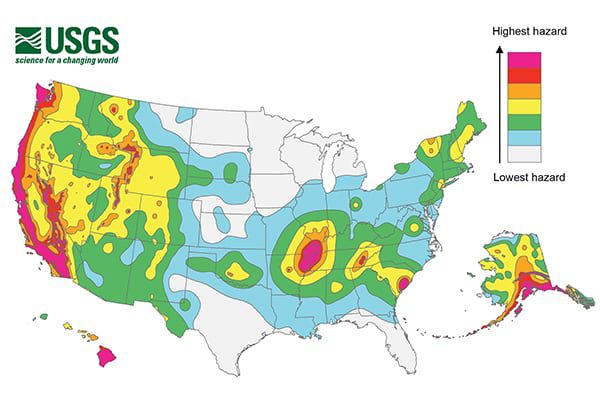 |
| 4. 2014 USGS National Seismic Hazard Map. This map displays the intensity of potential ground shaking from an earthquake within 50 years (the typical lifetime of a building). Courtesy: USGS |
Re-assessments don’t necessarily result in finding increased risk. In California, for example, the 2014 update found that “earthquake hazard extends over a wider area than previously thought. Most notably, faults were recently discovered, raising earthquake hazard estimates for San Jose, Vallejo and San Diego. On the other hand, new insights on faults and rupture processes reduced earthquake hazard estimates for Irvine, Santa Barbara and Oakland.”
Design Basis. NRC licensing of U.S. nuclear plants has involved using historical earthquake data for each site to determine the “design basis loads from the area’s maximum credible earthquake, with an additional margin included.” Existing plants were required to assess their potential vulnerability to quakes, including those that might exceed the design basis, as part of the Individual Plant Examination of External Events Program, a one-time assessment performed in the 1990s that took into account EPRI and LLNL hazard estimates at the time. The NRC explains that any new nuclear plants licensed will use a “probabilistic, performance-based approach to establish the plant’s seismic hazard and the seismic loads for the plant’s design basis.”
9/11 Response. Although the Sept. 11, 2001, terrorist attacks didn’t involve earthquakes, the steps required by the NRC in response to the attacks include those that could also add a level of safety in response to natural disasters such as earthquake, tornado, flood, and tsunami. In general, they require “plans, procedures, and pre-staged equipment whose intent is to minimize the effects of adverse events.”
NRC regulations require all nuclear plants to “maintain or restore cooling for the reactor core, containment building, and spent fuel pool under the circumstances associated with a large fire or explosion. These requirements include using existing or readily available equipment and personnel, having strategies for firefighting, operations to minimize fuel damage, and actions to minimize radiological release to the environment.”
Fukushima Response. After the mid-March 2011 accident at the Fukushima Daiichi plant, the NRC established the Near Term Task Force (NTTF), which issued a report making a series of recommendations, some of which were to be acted upon “without unnecessary delay.” The task force submitted its report in July 2011, and its recommendations (detailed online) have guided NRC actions, which have been broken into three tiers of activities: Tier 1—without delay, Tier 2—as resources become available, and Tier 3—long-term study.
On Mar. 23, 2011, just days after the Japanese tsunami, the NRC directed its inspectors to assess how U.S. plants were responding to the events in Japan. Inspectors were to “verify that important equipment and materials are adequate and properly staged, tested, and maintained in order to respond to a severe earthquake, flooding event, or loss of all electrical power. Inspections were completed by end of April 2011. The inspection reports are publicly available for each plant on the NRC website.”
The NRC also issued a “50.54(f) Letter” requesting information to confirm that its recommendations were being addressed by all U.S. nuclear plants. (Note that the NRC was already looking at new seismic hazards prior to the Fukushima accident.) An Electric Power Research Institute (EPRI) report, “Seismic Walkdown Guidance: For Resolution of Fukushima Near-Term Task Force Recommendation 2.3: Seismic,” provides guidance for conducting the seismic walkdowns required by that letter. As the summary of the EPRI report explains, every U.S. nuclear power plant was required to perform seismic walkdowns “to identify and address degraded, non-conforming or unanalyzed conditions and to verify the current plant configuration with the current seismic licensing basis. The nuclear power industry and the NRC agreed to cooperate in the development of guidelines and procedures to perform these walkdowns.”
The manner of achieving that goal on what EPRI characterized as an “aggressive” schedule entailed “using a sampling procedure that aligns the scope of the effort with the required schedule while achieving the objectives of the walkdowns.” (For more EPRI resources concerning this issue, see the sidebar.)
That sample:
includes representative items of equipment needed to safely shut down the reactor and maintain containment integrity. In some cases, equipment lists from the Individual Plant Examination for External Events (IPEEE) that were developed for plants in the early 1990’s can be used to identify the sample items. The sample needs to be suitably diverse across a spectrum of plant safety-related equipment including different classes of equipment. In keeping with the lessons learned by over thirty years of industry investigation of earthquake effects on mechanical and electrical equipment, the Seismic Walkdown Guidance includes a focus on equipment anchorage and seismic spatial interactions, as well as consideration of other potentially adverse seismic conditions such as seismically-induced fire and seismically-induced flood.
Following the NRC’s initial review of those walkdown reports, a November 2013 NRC letter notes that “regulatory site audits were conducted at a sampling of plants.” Based on the walkdown reports and site audits, the NRC requested additional information within 30 days. It found that “licensees’ interpretations of the seismic walkdown guidance varied, which resulted in meaningful differences in the process used,” and in particular, “the application of engineering judgment in determining what constituted a potentially adverse seismic condition.” The NRC closed out all outstanding walkdown issues with site-specific assessment reports. Additional work is ongoing, including site-specific seismic hazard reassessments and follow-up plant-specific evaluations using the updated seismic hazards.
As for the three tiers of activities to be undertaken in response to the Japanese accident, the NRC is addressing them with orders, requests for information, and rulemaking. Tier 1 activities (those conducted “without delay”), each detailed on the NRC site, are:
■ Mitigation strategies: To enhance the capability to maintain plant safety during a prolonged loss of electric power (order).
■ Containment venting system: To provide a reliable hardened containment vent system for boiling water reactors with Mark I [the design at the Fukushima Daiichi plant] or Mark II containment designs (order).
■ Spent fuel pool instrumentation: To provide a reliable wide-range indication of water level in spent fuel storage pools (order).
■ Seismic reevaluations: To reanalyze potential seismic effects using present-day information to determine if safety upgrades are needed (request for information).
■ Flooding hazard reevaluation: To reanalyze potential flooding effects using present-day information to determine if safety upgrades are needed (request for information).
■ Seismic and flooding walkdowns: To inspect existing plant protection features against seismic and flooding events, and correct any degraded conditions (request for information).
■ Emergency preparedness—staffing and communications: To assess staffing needs and communications capabilities to effectively respond to an event affecting multiple reactors at a site (request for information).
■ Station blackout mitigation strategies: To enhance the capability to maintain plant safety during a prolonged loss of electrical power (rulemaking).
■ Onsite emergency response capabilities: To strengthen and integrate different types of emergency procedures and capabilities at plants (rulemaking).
■ Filtration and confinement strategies: To evaluate potential strategies that may further confine or filter radioactive material if core damage occurs (rulemaking).
On July 9, 2014, the NRC approved consolidation of many post-Fukushima rulemaking activities and renamed it “Mitigation of Beyond-Design-Basis Events.” The final rule schedule remains unchanged; the final rule package is due to the NRC in December 2016. The scope includes station blackout mitigation strategies (SBOMS) and onsite emergency response capabilities. The NRC says that “The Mitigation of Beyond Design Basis Events rulemaking will permanently write into the agency’s rules the requirements already imposed by the Mitigation Strategies Order that was issued by the NRC on March 12, 2012. The eventual rule will ensure that if a plant loses power, it will have sufficient procedures, strategies, and equipment to cope with the loss of power for an indefinite amount of time.” It will also strengthen and integrate various emergency response capabilities at nuclear power plants.
Safe Enough?
There are no 100% guarantees where Mother Nature is concerned, even with the strongest precautions. However, the NRC quickly responded to concerns raised by the accident in Japan by calling for speedy inspections, assessments, and actions.
As noted, when new information becomes available, the NRC is charged with reviewing and responding to it. The NRC says, “The newest seismic data suggests that although the potential seismic hazard at some nuclear power plants in central and eastern states may have increased beyond previous estimates, all operating nuclear plants remain safe with no need for immediate action.”
Today’s U.S. operating environment presents both challenges and hope for nuclear plant owners. Although low natural gas prices currently challenge the economics of some nuclear plants, even many in the environmental community see nuclear power as a necessary component of a lower-carbon future. As long as high capital costs present seemingly insurmountable barriers to new nuclear capacity, it seems clear that it is in the best interest of existing facility owners to do their utmost to ensure that those plants can safely withstand seismic hazards. Though they cannot ensure there will be no earthquakes, they can take all appropriate precautionary measures to ensure that if a facility is affected by a previously unforeseeable event, the facility has all necessary equipment and procedures in place to mitigate the damage. ■
— Gail Reitenbach, PhD is POWER’s editor. Contributing Editor James Hylko contributed to this article.
